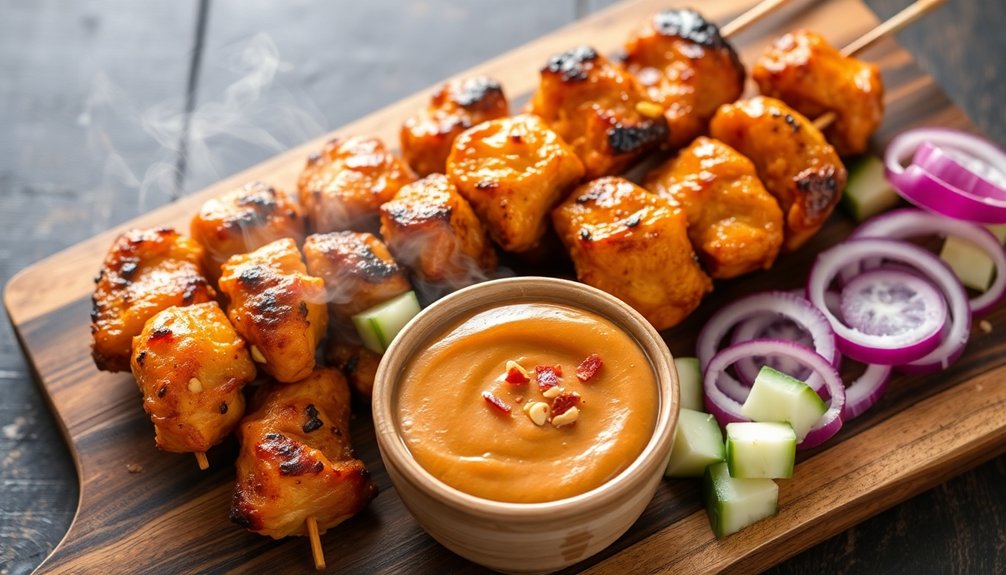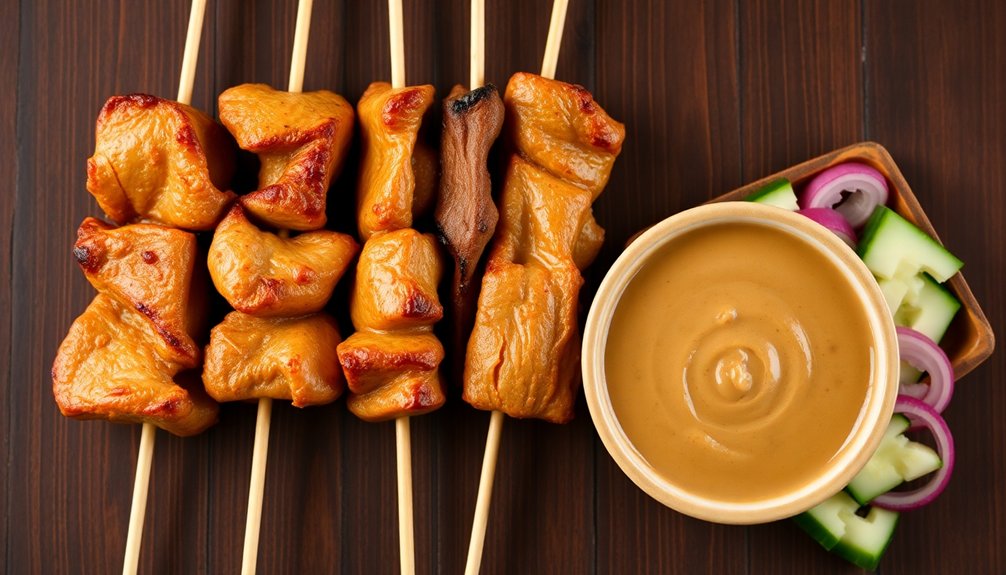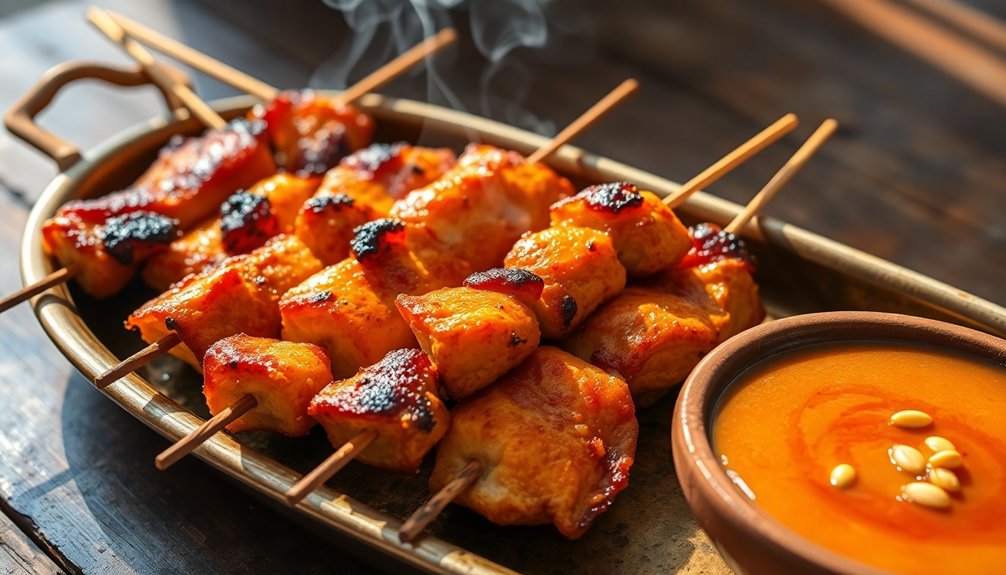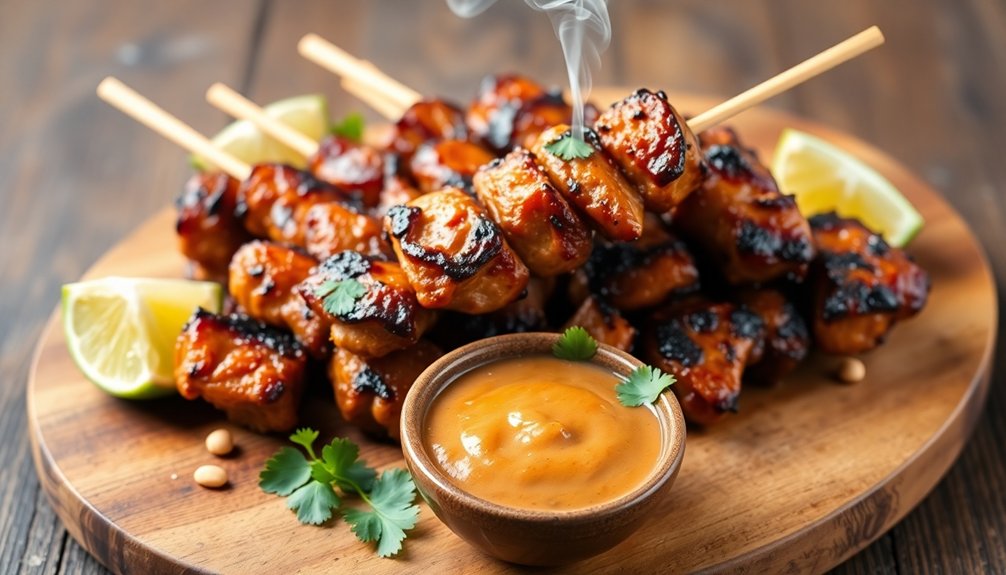Satay - Grilled Meat Skewers With Peanut Sauce
You'll discover authentic satay when tender, marinated meat chunks are threaded onto bamboo skewers, grilled over hot charcoal until charred, and served with a rich peanut dipping sauce. This beloved Southeast Asian dish originated in Java, Indonesia, where street vendors perfected the art of grilling skewered meats infused with aromatic spices like turmeric, coriander, and lemongrass. The secret to exceptional satay lies in proper marination and grilling techniques.
Key Takeaways
- Satay is a Southeast Asian grilled meat dish featuring marinated chicken, beef, or pork threaded onto bamboo skewers.
- Meat should marinate overnight in a blend of spices including turmeric, coriander, cumin, lemongrass, and garlic.
- Grill skewers at 400-450°F for 3-4 minutes per side until charred, basting with oil during cooking.
- Traditionally served with peanut sauce for dipping, along with cucumber slices, red onions, and rice.
- Originated in Java, Indonesia during the 19th century and spread throughout Southeast Asia through trade.
History

Though its exact origins remain debated, satay emerged in Java, Indonesia during the early 19th century, likely influenced by Indian kebab traders who visited the archipelago.
You'll find that satay's popularity quickly spread throughout Southeast Asia as traders and immigrants carried the dish across maritime routes.
The cultural significance of satay grew as street vendors, known as "satay men," became fixtures in night markets from Singapore to Malaysia.
Recipe

Ingredients:
- 1 lb chicken, beef, or pork, cut into 1-inch cubes
- Bamboo skewers, soaked in water
- Oil for basting
Marinade:
- 3 shallots, minced
- 2 cloves garlic, minced
- 2 tablespoons turmeric powder
- 1 tablespoon ground coriander
- 1 tablespoon ground cumin
- 2 stalks lemongrass, white part only, minced
- 2 tablespoons brown sugar
- 1 tablespoon fish sauce
- 2 tablespoons vegetable oil
- Salt to taste
Instructions:
- Blend all marinade ingredients into a smooth paste.
- Marinate meat pieces for 4-6 hours or overnight.
- Thread marinated meat onto skewers.
- Preheat grill to medium-high heat.
- Grill skewers 8-10 minutes, turning occasionally.
- Baste with oil while grilling.
- Cook until meat is charred on edges and cooked through.
Serve with:
- Peanut sauce
- Cucumber slices
- Red onions
- Ketupat or steamed rice
Cooking Steps

You'll need to begin preparation the night before by soaking wooden skewers in water and marinating your choice of meat in the spice mixture.
Once you're ready to cook, thread the marinated meat onto the pre-soaked skewers and heat your grill until it's smoking hot.
Grill the satay skewers for 3-4 minutes per side until they develop a rich, caramelized brown color with slightly charred edges.
Step 1. Soak Wooden Skewers Overnight
Before preparing satay, soaking wooden skewers overnight in water is essential to prevent them from burning during the grilling process.
You'll need to submerge the bamboo or wooden skewers completely in cold water for at least 8 hours, though 12 hours is ideal. Place them in a shallow dish or container and weigh them down with a small plate to guarantee they stay fully immersed.
If you're short on time, you can use a quick soaking technique by boiling the skewers for 20 minutes, though this isn't as effective as the overnight method.
While metal skewers don't require soaking, traditional bamboo or wooden ones are preferred as they impart a subtle flavor to the meat and maintain authenticity in Southeast Asian cooking.
Step 2. Marinate Meat Overnight
While your skewers are soaking, marinating the meat is the next step that brings satay's signature flavors to life.
Cut your chicken, beef, or lamb into 1-inch cubes, ensuring uniform sizes for even cooking. Create your marinade by blending lemongrass, galangal, turmeric, garlic, shallots, coriander, and cumin with coconut milk and brown sugar.
Different regions offer unique marinade variations - Javanese-style often includes kecap manis (sweet soy sauce), while Malaysian versions might incorporate more turmeric and curry powder.
The overnight benefits are essential - this 8-12 hour process allows the enzymes in the marinade to tenderize the meat while the flavors deeply penetrate each piece.
You'll notice the meat taking on a beautiful yellow-orange hue from the turmeric and spices.
Step 3. Thread Meat Onto Skewers
After the marination period, threading the meat onto bamboo skewers requires a methodical approach for the best results.
Take each piece of marinated meat and thread it in a weaving pattern, ensuring the pieces are touching but not tightly packed. This traditional skewer technique allows heat to circulate evenly around each piece while keeping the meat juicy.
For your meat selection, choose pieces that are roughly the same size - about 1-inch cubes for chicken or beef, slightly thinner strips for pork.
Press the meat down firmly onto the skewer, leaving about 2 inches of handle space at the bottom and 1 inch at the top. You'll want to thread 4-5 pieces per skewer, making sure they're secure enough to turn during grilling without spinning independently.
Step 4. Preheat Grill Until Hot
Since proper grill temperature is essential for achieving authentic satay's signature char, you'll need to preheat your grill to high heat, around 400-450°F (204-232°C).
This traditional cooking method requires intense heat to quickly sear the meat's exterior while keeping the inside tender and juicy.
If you're using a charcoal grill, spread the hot coals evenly and wait until they're covered with white ash.
For a gas grill, turn all burners to high and close the lid for 10-15 minutes.
You'll know your grill's ready when you can hold your hand about 4 inches above the grates for only 2-3 seconds before it feels too hot.
Don't rush this step - proper preheating guarantees your satay will have that authentic street food char and won't stick to the grates.
Step 5. Grill Skewers Until Browned
Place the marinated skewers on your preheated grill at a slight angle across the grates, spacing them about an inch apart to guarantee even cooking.
Cook for 3-4 minutes until you see the edges browning and caramelizing, then flip them carefully using tongs. The meat should release easily from the grates when it's ready to turn.
Continue grilling for another 3-4 minutes on the second side, occasionally basting with the remaining marinade to keep the meat moist.
Don't leave the grill unattended, as the sugar in the marinade can cause flare-ups.
Your satay is done when the meat reaches an internal temperature of 165°F (74°C) for chicken, or 145°F (63°C) for beef or lamb, and displays an appealing golden-brown color with light charring on the edges.
Cooking Tips

Three critical tips guarantee perfectly grilled satay every time.
First, when selecting meat, choose cuts with some marbling like chicken thigh or pork shoulder - they'll stay juicier than lean cuts. Cut against the grain into uniform strips to guarantee even cooking and tenderness.
For ideal grilling techniques, don't overcrowd your skewers - leave small gaps between meat pieces to allow heat circulation and even browning.
Keep the meat elevated above direct flames to prevent burning, and maintain a medium-high heat around 375-400°F (190-200°C).
You'll want to baste the meat while grilling, but wait until the exterior has started to brown. This helps the marinade stick better and creates a glossy finish without causing flare-ups.
Turn the skewers every 2-3 minutes for consistent results.
Final Thoughts
While satay may seem intimidating at first, mastering this beloved Southeast Asian dish is well worth the effort. Once you understand the basics of marination and grilling techniques, you'll be creating restaurant-quality satay in your own backyard.
The cultural significance of satay extends beyond its delicious taste – it's a dish that brings people together at street food stalls, family gatherings, and celebrations throughout Southeast Asia.
For serving suggestions, consider presenting your satay on a banana leaf-lined platter alongside cucumber slices, red onions, and cubed rice cakes.
Don't forget to serve plenty of peanut sauce for dipping. You'll find that satay isn't just about the food – it's about embracing the communal dining experience that's so central to Southeast Asian culture.

Frequently Asked Questions
Can Satay Be Made Ahead of Time and Reheated?
In the blink of an eye, you'll find satay storage is simple—refrigerate up to 3 days. When you're ready, gently reheat using a grill, oven, or stovetop while avoiding overcooking.
What's the Best Way to Prevent Wooden Skewers From Burning?
You'll prevent wooden skewer burning by soaking them in water for 30 minutes before grilling. If you're grilling often, consider investing in reusable metal or stainless steel alternative materials instead.
How Long Can Leftover Peanut Sauce Be Stored in the Refrigerator?
Cool as a cucumber, your homemade peanut sauce will stay fresh for up to a week when stored properly. Keep it in an airtight container, and you'll enjoy maximum sauce freshness.
Are There Vegetarian Alternatives for Traditional Satay?
You'll find delicious vegetarian options using firm tofu, tempeh, seitan, or mushrooms. These plant-based satay alternatives work perfectly with traditional marinades and capture authentic Southeast Asian flavors beautifully.
Which Cuts of Meat Work Best for Making Satay?
Like a ninja choosing weapons, you'll want chicken thighs, tender beef sirloin, or pork shoulder. These best meat cuts respond wonderfully to marinating techniques, staying juicy while developing perfect char.
